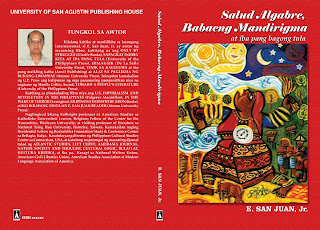Kilalang kritiko at manlilikha sa larangang internasyonal, si E. SAN JUAN, Jr. ay emeritus professor of English, Comparative Literature, and Ethnic Studies, University of Connecticut & Washington State University. Siya’y awtor ng maraming libro, kabilang na ang Balikbayang Sinta: An E. San Juan Reader (Ateneo University Press), Kontra-Modernidad (University of the Philippines Press), Tinik sa Kaluluwa; Rizal In Our Time (Anvil Publishing), Bakas Alingawngaw (Ateneo University Press), Salud Algabre (University of San Agustin Publishing House), at Ulikba at mga bagong tula; at Learning from the Filipino Diaspora (U.S.T. Publishing House).
Inilathala ng Lambert Academic Publishing Co., Saarbrucken, Germany, ang kaniyang Critical Interventions: From Joyce and Ibsen to Peirce and Kingston, kasunod ng In the Wake of Terror (Lexington), US Imperialism and Revolution in the Philippines (Palgrave), at Carlos Bulosan: Revolutionary Filipino Writer in the U.S. (Peter Lang).
Ilulunsad ng U.S.T. Press sa taong ito ang bagong libro niya: Faustino Aguilar: Kapangyarihan, Kamalayan, Kasaysayan, Isang Metakomentary sa mga Nobela ni F. Aguilar--pinakaunang libro ng makabagong panunuri sa mga akda ng isang rebolusyonaryong tagapagtatag ng panitikang Filipino.
Naglingkod siya bilang Fulbright professor of American Studies sa Katholieke Universiteit Leuven, Belgium; Fellow, Center for the Humanities, Wesleyan University; visiting professor of literature sa National Tsing Hua University, Hsinchu, Taiwan. Kamakailan, siya ay naging Residential Fellow ng Rockefeller Foundation Study & Conference Center sa Bellagio, Italya, at Fellow sa W.E.B. Institute, Harvard University. Siya ay kasalukuyang director ng Philippines Cultural Studies Center sa Washington, DC, USA, at katulong na patnugot ng maraming dyornal tulad ng Cultural Logic, Kultura Kritika, Unitas, at iba pa. Kasapi siya sa American Civil Liberties Union, Democratic Socialists of America, at Modern Language Association of America. Kamakailan, naging chair professor of Cultural Studies, Polytechnic University of the Philippines, at visiting professor of English, University of the Philippines.






